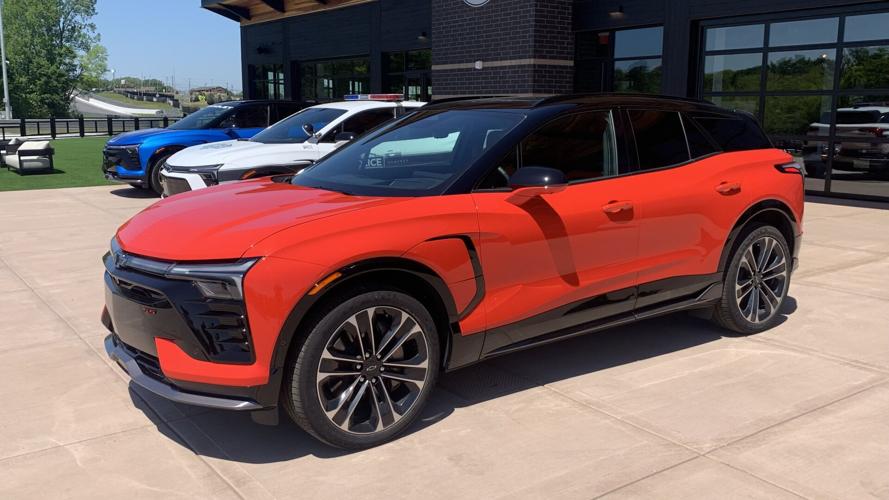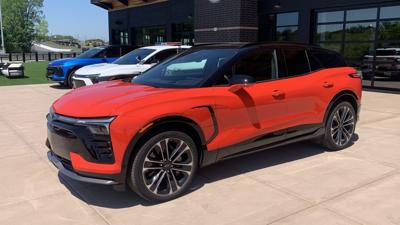CONCORD, N.C.ŌĆöI canŌĆÖt remember the last time I experienced such braking force. At least, when I was behind the wheel. It’s incredible!
Recently, I was on a closed course in North Carolina to test the track performance of the all-new 2025 Chevrolet Blazer EV SS. One of the exercises Chevy put me through is launch control, which I have done before, but not in an EV. Launch control consists of putting the foot to the floor on both the brake and accelerator pedals at the same time. You then lift your left foot off the brake and launch the car.
Simple, right?
Not this time.
I kinda screwed it up.
I had my Blazer EV SS tester pointed down the front straight on track, and once I got the OK from my co-pilot, a Chevy engineer, I lifted my left foot off the brake. And my Radiant Red Tintcoat Blazer EV SS rocketed down the track with such force, the back of my head hit the headrest. 0-97 km/h in 3.4 seconds? Can confirm.
Bright orange cones marked the braking point down range, but my brain didnŌĆÖt switch back to right-foot braking, so, instead, I used my left. Big mistake. I donŌĆÖt normally use my left foot for anything except clutch work, which is a rare occurrence in new cars these days.
Instead of decelerating smoothly, my left foot mashed the brake pedal. Hard. I jerked myself and the engineer violently forward. The car went into limp mode. OnStar, GMŌĆÖs emergency services hotline, called in asking us if we were OK and needed help. We didnŌĆÖt. But I couldŌĆÖve used some for my acute case of embarrassment.
The warning symbol on the gigantic 17.7-inch infotainment display was dismissed after I parked the car trackside and opened the door to restart. Everything was fine. I apologized profusely to the engineer. He took it in stride. As my embarrassment began to fade, I cracked a lame joke about how good the SS’s Brembo brakes are. He laughed. Or humoured me at least. We carried on without further incident.
So, if you wanted to know if the Blazer EV SS is, indeed, a performance machine, my experience is proof positive that it is. The SS model, which joins the LT and RS in the Blazer EV lineup, gets all the performance kit Chevy can throw at it.
The most important is propulsion, which comes from dual electric motors and a 102-kWh lithium-ion battery. Total output is rated at 615 horsepower and 650 lbs.-ft. of torque, or motive force.
To match its immense power, Chevy has beefed up the Blazer EV SS chassis. This means stiffer anti-roll bars and stiffer front and rear springs, which are 60 per cent and 30 per cent firmer, respectively, than those on the regular Blazer EV. These changes contribute to a sportier ride, while a faster steering ratio and Monotube dampers deliver quicker steering and vehicle response.
Standard 22-inch wheels and low-profile Michelin all-season tires also help with the steering. Optional Continental summer performance tires included in the Performance Package ($495) improve handling and grip even more. Then thereŌĆÖs the stopping force from the Brembo brakes, which performed quite well during my accidental test.
These enhancements really make a difference for road driving. While the Blazer EV SS handles well enough on track, itŌĆÖs not designed for this use. Chevy reps talked a lot about its ŌĆ£canyon carvingŌĆØ abilities during the product briefing, and I think itŌĆÖs a good descriptor, based on my experience on Charlotte-area roads.
Its stiffer chassis, bigger tires and excellent brakes make the Blazer EV SS a fun car for zooming along on two-lane country roads, of which there are many in the Charlotte area. Body lean is minimal, steering feels light and accurate, and its big power output make for a very fast performance EV. Canyon carver, indeed.
And the performance character extends to the cabin. The flat bottom steering wheel, adrenalin-red, perforated synthetic leather seats, and large digital displays really drive the sporty feel. The displays, especially the 17.7-inch multimedia touchscreen, are customizable, with pin-sharp graphics and a glut of deep colour.
Because the centre display is powered by Google, it doesnŌĆÖt support phone-tethering with Apple CarPlay or Android Auto. But native Google Maps worked well in my test vehicle, and I didnŌĆÖt miss CarPlay much. It is something buyers should consider, however. Of note, most GM EVs use the same tech.
Overall, the Blazer EV SS checks EV boxes, with up to 190-kW charging speeds and 488 km of range. It can also be fitted with a NACS DC adapter ($325) for use on the Tesla Supercharger network.
The Blazer EV SS┬Āhas a lot going for it; it offers sharp styling, loads of standard high-tech features ŌĆ” oh, and blistering performance.






























To join the conversation set a first and last name in your user profile.
Sign in or register for free to join the Conversation